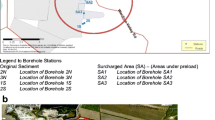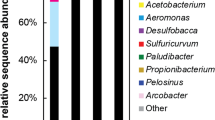Abstract
Pyrite undergoes oxidation when exposed to aqueous oxygen to produce acidic leachate with high concentrations of H+, SO42−, and Fe3+. The oxidation mechanism is currently ascribed to contact between the mineral and aqueous oxygen. Consequently, management of acidic leachate from acid sulfate soils and acid mine drainage is focused on the prevention of contact between the sediment and aqueous oxygen through the surface. Intriguing though is the fact that in aquatic sediments, redox processes occur in sequence with the oxidizing agents. Among the common oxidants in aquatic sediments are O2, \( {\mathrm{NO}}_3^{-} \), Mn, and Fe, in the order of efficiency. Consequently, following the depletion of oxygen in pyrite-rich sediment, it would be expected that \( {\mathrm{NO}}_3^{-} \), followed by Mn and then Fe, would continue the oxidation process. However, evidence of anaerobic pyrite oxidation in a naturally occurring pyrite-rich sediment is limited. Few studies have investigated the process in aquatic systems but mostly in laboratory experimental set ups. In this study, pyrite oxidation in a naturally occurring pyrite-rich sediment was investigated. A section of the sediment was covered with surface surcharge, in the form of compacted fill. The section of the sediment outside the surcharged area was preserved and used as control experiment. Solid phase soil and porewater samples were subjected to elemental, mineralogical, and microbial analyses. The results show excess accumulation of sulfate and sulfide in the anoxic zones of the original sediment and beneath the surcharge, accompanied by the disappearance of \( {\mathrm{NO}}_3^{-} \), Mn, and Fe in the anoxic zones, indicating electron transfers between donors and acceptors, with pyrite as the most likely electron donor. The study outcome poses a significant challenge to the use of surface cover for the management of acidic leachate from pyrite oxidation, particularly, in areas rich in \( {\mathrm{NO}}_3^{-} \), MnO−2, or Fe.




Similar content being viewed by others
References
Abicht, H. K., Mancini, S., Karnachuk, O. V., & Solioz, M. (2011). Genome sequence of Desulfosporosinus sp. OT, an acidophilic sulfate-reducing bacterium from copper mining waste in Norilsk, Northern Siberia. Journal of Bacteriology, 193, 6104–6105.
Aller, R. C., & Rude, P. D. (1988). Complete oxidation of solid phase sulfides by manganese and bacteria in anoxic marine sediments. Geochimica et Cosmochimic Acta, 52, 751–765.
Appelo, C. A. J., & Postma, D. (2005). Geochemistry, groundwater and pollution. The Netherlands: A. A. Balkema Publishers.
Berner, R. A. (1970). Sedimentary pyrite formation. American Journal of Science, 268, 1–23.
Bronswijk, J. J. B., Nugroho, K., Aribawa, I. B., Groenenberg, J. E., & Ritsema, C. J. (1993). Modeling of oxygen transport and pyrite oxidation in acid sulfate soils. J. Environmental Quality, 22, 544–554.
Cook, F. J., Dobos, S. K., Carlin, G. D., & Millar, G. E. (2004). Oxidation rate of pyrite in acid sulfate soils: in situ measurements and modelling. Australian Journal of Soil Research, 42, 499–507.
Dent, D. (1986). Acid sulfate soils: a baseline for research and development. In Wageningen. The Netherlands: International Institute for Land Reclamation and Inprovement (ILRI).
Froelich, P. N., Klinkhammer, G. P., Bender, M. L., Luedtke, N. A., Heath, G. R., Cullen, D., & Dauphin, P. (1979). Early oxidation of organic matter in pelagic sediments of the eastern equatorial Atlantic: suboxic diagenesis. Geochimica et Cosmochimica Acta, 43, 1075–1090.
Garcia-Gil, L. J., & Golterman, H. L. (1993). Kinetics of FeS-mediated denitrification in sediments from the Camargue (Rhode delta, Southern France). FEMS Microbiology Ecology, 13, 85–92.
Garrels, R. M. & Thompson, M. E. 1960. Oxidation of pyrite by iron sulfate solutions. American journal of science, Bradley Volume, Vol. 258-A, 57–67.
Goker, M., Teshima, H., Lapidus, A., Lucas, S., et al. (2011). Complete genome sequence of the acetate-degrading sulfate reducer Desulfobacca acetoxidans type strain (ASRB2T). Standards in Genomic Sciences, 4, 393–401.
Hengstmann, U., Chin, K., Janssen, P. H., & Liesack, W. (1999). Comparative phylogenetic assignment of environmental sequences of genes encoding 16S rRNA and numerically abundant culturable bacteria from an anoxic rice paddy soil. Applied and Environmental Microbiology, 65, 5050–5058.
Hill, G. T., Mitkowski, N. A., Aldrich-Wolfe, L., Emele, L. R., Jurkonie, D. D., Ficke, A., Maldonado-Ramirez, S., Lynch, S. T., & Nelson, E. B. (2000). Methods for assessing the composition and diversity of soil microbial communities. Applied Soil Ecology, 15, 25–36.
Holmer, M., & Storkholm, P. (2001). Sulfate reduction and sulfur cycling in lake sediments: a review. Freshwater Biology - Special Review, 46, 431–451.
Jorgensen, B. B. (1977). The sulfur cycle of a coastal marine sediment (Limfjorden, Denmark). Limnology and Oceanography, 22, 814–832.
Jorgensen, B. B., & Bak, F. (1991). Pathways and microbiology of thiosulfate transformations and sulfate reduction in a marine sediment (Kattegat, Denmark). Applied and Environmental Microbiology, 57, 847–856.
Jorgensen, C. J., Jacobsen, O. S., Elberling, B., & Aamand, J. (2009). Microbial oxidation of pyrite coupled to nitrate reduction in anoxic groundwater sediment. Environmental Science & Technology, 43, 4851–4857.
Karikari-Yeboah, O., & Addai-Mensah, J. (2017). Assessing the impact of preload on pyrite-rich sediment and groundwater quality. Environmental Monitoring and Assessment, 189, 1–19.
Karikari-Yeboah, O., Skinner, W., & Addai-Mensah, J. (2018). The impact of preload on the mobilisation of multivalent trace metals in pyrite-rich sediment. Environmental Monitoring and Assessment, 190, 1–14.
Kosaka, T., Kato, S., Shimoyama, T., Ishii, S., Abe, T., & Watanabe, K. (2008). The genome of Pelotomaculum thermopropionicum reveals niche-associated evolution in anaerobic microbiota. Genome Research, 18, 442–448.
Luther, G. W. (1987). Pyrite oxidation and reduction: Molecular orbital theory considerations. Geochimica et Cosmochimic Acta, 51, 3193–3199.
Pester, M., Bittner, N., Deevong, P., Wagner, M., & Loy, A. (2010). A ‘rare biosphere’ microorganism contributes to sulfate reduction in a peatland. The ISME Journal, 4, 1591–1602.
Sanchez-Andrea, I., Knittel, K., Amann, R., Amils, R., & Sanz, J. L. (2012). Quantification of Tinto River sediment microbial communities: importance of sulfate-reducing bacteria and their role in attenuating acid mine drainage. Journal Applied and Environmental Microbiology, 78, 4638–4645.
Schippers, A., & Jorgensen, B. B. (2001). Oxidation of pyrite and iron sulfide by manganese dioxide in marine sediments. Geochimica et Cosmochim. Acta, 65, 915–922.
Sieber, J. R., Sims, D. R., Han, C., Kim, E., Lykidis, A., Lapidus, A. L., Mcdonald, E., Rohlin, L., Culley, D. E., Gunsalus, R., & Mclnerney, M. J. (2010). The genome of Syntrophomonas wolfei: new insights into syntrophic metabolism and biohydrogen production. Environmental Microbiology, 12, 2289–2301.
Singer, P. C., & Stumm, W. (1970). Acidic mine drainage: the rate-determining step. Science, New Series, 167, 1121–1123.
Szogi, A. A., Hunt, P. G., Sadler, E. J., & Evans, D. E. (2004). Characterization of oxidation-reduction processes in constructed wetlands for swine wastewater treatment. Applied Engineering in Agriculture, 20, 189–200.
Walpole, R. E., & Myers, R. H. (1989). Probability and statistics for engineers and scientists. Boston: Boston Pearson Education.
Wheel, K. G. & Feasby, G. (1991). Innovative decommission technologies via Canada’s MEND program. the 12th Nat. Conf., Hazardous Mater. Control/Superfund ‘91, Hazardous Mater Control Res. Inst., 23–28.
Wiersma, C. L., & Rimstidt, J. D. (1984). Rates of reaction of pyrite and marcasite with ferric iron at pH 2. Geochimica et Cosmochimic Acta, 48, 85–92.
Williamson, M. A., & Rimstidt, J. D. (1994). The kinetics and electrochemical rate-determining step of aqueous pyrite oxidation. Geochimica et Cosmochimic Acta, 58, 5443–5454.
Yanful, E. K. (1993). Oxygen diffusion through soil covers on sulphidic mine tailings. Journal of Geotechnical Engineering, 119, 1207–1228.
Acknowledgements
This research was founded by Maiden Geotechnics and Australian Commonwealth Scholarship awarded by the University of South Australia to the first author.
Author information
Authors and Affiliations
Corresponding author
Ethics declarations
Conflict of interest
The authors declare that they have no conflict of interest.
Additional information
Publisher’s note
Springer Nature remains neutral with regard to jurisdictional claims in published maps and institutional affiliations.
O. Karikari-Yeboah formally of University of South Australia.
Rights and permissions
About this article
Cite this article
Karikari-Yeboah, O., Skinner, W. & Addai-Mensah, J. Anaerobic pyrite oxidation in a naturally occurring pyrite-rich sediment under preload surcharge. Environ Monit Assess 191, 216 (2019). https://doi.org/10.1007/s10661-019-7289-3
Received:
Accepted:
Published:
DOI: https://doi.org/10.1007/s10661-019-7289-3




